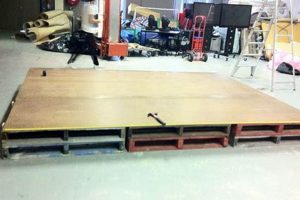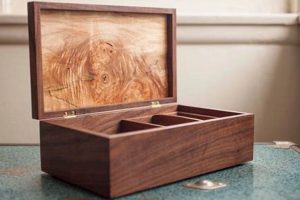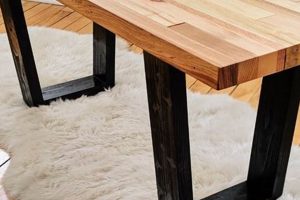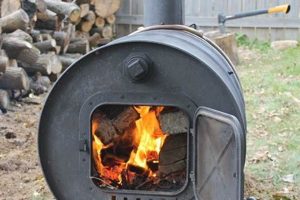Creating custom furniture supports using natural-edge timber offers a unique aesthetic for tables. This approach involves selecting timber pieces that retain their original bark and contours, lending a rustic and organic element to interior design. A common application is crafting supports for tabletops, where the raw, untouched edges of the wood are prominently displayed.
Employing this method allows for personalized furniture design that highlights the inherent beauty of wood. This approach often prioritizes sustainability by utilizing salvaged or repurposed timber, minimizing environmental impact. Historically, integrating natural materials into furniture construction reflects a connection to craftsmanship and the appreciation of organic forms in the built environment.
The subsequent sections will delve into the specific techniques and considerations required for the successful fabrication of these distinctive table components, including timber selection, preparation, joinery methods, and finishing processes.
Essential Considerations for Natural-Edge Table Supports
The following guidelines offer crucial insights for individuals undertaking the construction of table supports from natural-edge timber. Attention to these details ensures both structural integrity and aesthetic appeal.
Tip 1: Timber Selection: Prioritize hardwoods such as oak, maple, or walnut due to their superior strength and stability. Inspect each piece for signs of rot, insect infestation, or significant cracking, as these compromise the structural soundness of the supports.
Tip 2: Moisture Content Assessment: Accurately measure the timber’s moisture content. Wood with excessive moisture is prone to warping and shrinkage. Aim for a moisture content consistent with the intended indoor environment, typically between 6% and 8%.
Tip 3: Bark Stabilization: Apply a suitable consolidant to the bark to prevent flaking or detachment. Consider using a penetrating epoxy resin specifically designed for bark stabilization, carefully following the manufacturer’s instructions.
Tip 4: Joinery Methods: Employ robust joinery techniques such as mortise-and-tenon or metal brackets to ensure a secure connection between the supports and the tabletop. Proper alignment and secure fastening are critical for stability.
Tip 5: Surface Preparation: Thoroughly clean the wood surface, removing dirt, debris, and loose fibers. Sand the wood to a smooth finish, using progressively finer grits of sandpaper to achieve the desired texture.
Tip 6: Finishing Application: Select a durable finish that protects the wood from moisture and wear. Consider options such as polyurethane or lacquer, applying multiple coats according to the manufacturer’s recommendations.
Tip 7: Weight Distribution Analysis: Assess the weight of the intended tabletop and ensure that the natural-edge supports are adequately sized and positioned to bear the load safely. Consult structural guidelines if necessary.
Adherence to these recommendations facilitates the creation of aesthetically pleasing and structurally sound table supports, resulting in a functional and enduring piece of furniture.
The subsequent section will address common challenges encountered during the creation process and offer practical solutions.
1. Timber Source
The timber source constitutes a foundational element in the construction of natural-edge table supports. The species of tree from which the timber originates directly influences its structural properties, durability, and aesthetic characteristics. Hardwoods such as oak, maple, and walnut are frequently selected for their inherent strength and resistance to wear, providing a stable base for the table. Conversely, softwoods may lack the necessary density to adequately support the tabletop, leading to potential instability or failure over time. The provenance of the timber, whether sourced from a sustainable forest or reclaimed from a previous structure, also carries implications for environmental responsibility and the overall carbon footprint of the project.
Furthermore, the specific characteristics of individual timber pieces, such as the grain pattern and presence of knots or imperfections, significantly contribute to the unique visual appeal of supports crafted from natural-edge lumber. For example, a piece of black walnut with a pronounced burl can impart a distinctive character to the table, enhancing its perceived value and artistic merit. Careful consideration of the timber source allows the artisan to leverage the inherent qualities of the wood to achieve the desired aesthetic outcome. Reclaimed wood, distinguished by its aged patina and history, introduces an additional layer of narrative into the finished piece.
In summary, the selection of an appropriate timber source is paramount for ensuring the structural integrity, longevity, and aesthetic success of table supports fashioned from natural-edge lumber. Prioritizing hardwoods, considering sustainability practices, and evaluating individual piece characteristics will contribute to a robust and visually compelling outcome. Neglecting to account for these factors may compromise the stability and aesthetic value of the final product.
2. Edge Stabilization
The longevity and aesthetic integrity of table supports fashioned from natural-edge timber are directly contingent upon effective edge stabilization. The bark and cambium layers present on live-edge wood are inherently prone to detachment and degradation due to fluctuations in humidity, temperature, and physical contact. Without adequate stabilization, these elements will eventually separate from the underlying wood, compromising the visual appeal and structural integrity of the table supports. The absence of a robust stabilization process renders the supports vulnerable to damage, reducing their lifespan and increasing the potential for costly repairs or replacement.
Effective edge stabilization techniques typically involve the application of penetrating sealants or consolidants designed to bind the bark and cambium layers to the wood. These compounds permeate the cellular structure, creating a durable barrier against moisture and preventing the propagation of cracks or fissures. In practice, a common method involves the use of epoxy resins specifically formulated for wood stabilization. These resins are carefully applied to the edges, ensuring thorough penetration and saturation. Excess resin is then removed, and the surface is allowed to cure, forming a hardened layer that reinforces the natural edge. Another option is the application of cyanoacrylate adhesives, particularly for smaller areas of loose bark. Multiple thin coats are applied, allowing each to dry before applying the next, gradually building up a stable surface. Failure to correctly apply these techniques leads to predictable outcomes, such as bark delamination and loss of the aesthetic appeal that defines the table supports.
In conclusion, edge stabilization is a critical component in the construction of table supports utilizing natural-edge timber. Neglecting this step results in a significant reduction in the lifespan and aesthetic quality of the finished product. The application of appropriate stabilization techniques, such as penetrating epoxy resins or cyanoacrylate adhesives, is essential for preserving the natural beauty and structural integrity of the table supports, ensuring a lasting and visually appealing addition to any interior space. Addressing the challenges of edge stabilization allows for the realization of designs that showcase the inherent beauty of natural wood, while maintaining long-term durability and functionality.
3. Joinery Strength
The structural integrity of table supports fabricated from natural-edge timber is fundamentally dependent on the strength of the joinery connecting the supports to the tabletop. Adequate joint strength is paramount to ensure the stability and safety of the finished table, preventing catastrophic failure under load and maintaining the table’s functionality over time.
- Mortise and Tenon Joints
This traditional woodworking technique involves fitting a projecting tenon (end of one piece of wood) into a mortise (a hole or recess) in another. In the context of natural-edge table supports, a well-executed mortise and tenon joint provides exceptional resistance to shear forces and prevents racking. For instance, a robust mortise and tenon joint can effectively distribute the weight of a heavy tabletop across the supports, mitigating stress concentrations and minimizing the risk of joint failure.
- Metal Fasteners and Brackets
The strategic use of metal fasteners, such as screws, bolts, and lag bolts, in conjunction with metal brackets, offers a reliable means of securing natural-edge table supports. When selecting fasteners, appropriate size, material, and corrosion resistance are critical factors. For example, stainless steel lag bolts provide exceptional holding power in dense hardwoods and resist corrosion in humid environments. Metal brackets strategically positioned at critical stress points can significantly enhance joint strength, preventing separation under heavy loads. These techniques are employed when traditional joinery is either impractical or insufficient.
- Epoxy Resin Adhesives
Epoxy resin adhesives offer a high-strength bonding solution for joining natural-edge timber. These adhesives create a durable and waterproof bond that resists separation under stress. In the construction of table supports, epoxy resin can be used to reinforce traditional joinery, such as dovetail joints, or to bond metal fasteners to the wood. For example, injecting epoxy resin into pilot holes before installing screws significantly enhances the holding power of the screws, preventing them from loosening over time. This technique is especially valuable when working with irregular or uneven surfaces.
- Timber Selection and Preparation
The species and quality of the timber used in the joinery significantly influence joint strength. Hardwoods, such as oak and maple, offer superior holding power for fasteners compared to softwoods. Proper preparation of the mating surfaces is also critical. Surfaces must be clean, dry, and free of loose debris to ensure optimal adhesion. For example, sanding the mating surfaces with a coarse grit sandpaper before applying adhesive creates a mechanical key that enhances the bond strength. Timber with excessive moisture content is prone to shrinkage and warping, which can compromise joint integrity over time. Kiln-dried timber with a moisture content appropriate for the intended environment is recommended.
In conclusion, achieving adequate joinery strength is paramount for the successful construction of stable and durable table supports from natural-edge timber. The selection and execution of appropriate joinery techniques, combined with careful attention to timber selection and surface preparation, directly influence the longevity and safety of the finished table. Neglecting these factors can result in structural instability and premature failure of the supports, compromising the investment and potentially posing a safety hazard.
4. Finish Durability
Finish durability is a critical attribute governing the longevity and aesthetic preservation of table supports crafted from natural-edge timber. The finish serves as a protective barrier against environmental factors, including moisture, ultraviolet radiation, and physical abrasion, all of which can degrade the wood and compromise its structural integrity. Selecting an appropriate finish and applying it correctly are essential for ensuring that the supports maintain their appearance and function over an extended period. For instance, a table situated in a sunlit room requires a finish with UV inhibitors to prevent fading and discoloration of the wood. Similarly, a table used for dining necessitates a finish resistant to spills and scratches from utensils. The absence of a durable finish leaves the wood vulnerable to damage, resulting in premature wear, discoloration, and potential structural issues.
Different types of finishes offer varying levels of protection and aesthetic qualities. Polyurethane coatings provide excellent resistance to abrasion and moisture, making them suitable for high-traffic areas. However, they may impart a plastic-like appearance, which may not align with the desired aesthetic for natural-edge wood. Oil-based finishes, such as tung oil or linseed oil, enhance the natural grain and color of the wood, but offer less protection against scratches and spills. Water-based finishes are environmentally friendly and dry quickly, but may not be as durable as solvent-based options. The choice of finish depends on a balance between desired aesthetic properties, level of protection required, and ease of application. Proper surface preparation, including sanding and cleaning, is crucial for ensuring optimal adhesion and performance of the finish. Multiple thin coats are generally preferable to a single thick coat, as they provide better coverage and reduce the risk of runs or drips.
In summary, the durability of the finish applied to natural-edge table supports directly influences their lifespan and aesthetic appeal. Selection of an appropriate finish based on the intended use and environmental conditions, coupled with meticulous surface preparation and application techniques, is essential for maximizing protection and maintaining the beauty of the wood. Neglecting finish durability can lead to premature degradation, requiring costly repairs or replacement. The investment in a high-quality, durable finish ultimately safeguards the value and longevity of the table supports.
5. Weight Capacity
Weight capacity, in the context of constructing supports using natural-edge timber, denotes the maximum load that the supports can bear without compromising structural integrity. This parameter is of paramount importance, as it directly impacts the safety and longevity of the resulting table. Insufficient weight capacity can lead to catastrophic failure, posing a significant risk of injury and property damage.
- Species Selection and Load-Bearing Capability
Different wood species exhibit varying degrees of strength and density, directly influencing their ability to withstand applied loads. Hardwoods such as oak, maple, and walnut possess superior load-bearing capabilities compared to softwoods like pine or cedar. Selecting an appropriate species is crucial for ensuring that the supports can adequately bear the weight of the tabletop and any additional items placed upon it. For example, a large conference table constructed with a granite top necessitates supports fabricated from a dense hardwood to provide adequate support, while a small side table might suffice with a less robust softwood.
- Support Dimensions and Geometry
The dimensions and geometric configuration of the timber significantly influence weight-bearing capabilities. Wider and thicker supports inherently possess greater strength than narrower and thinner ones. The shape of the support, whether cylindrical, rectangular, or tapered, also affects its load-bearing capacity. A rectangular support oriented with its wider dimension vertically will exhibit greater resistance to bending than one oriented with its narrower dimension vertically. Analyzing the intended load and strategically designing the support dimensions is crucial for preventing deformation or collapse.
- Joinery Techniques and Load Distribution
The method of joining the supports to the tabletop significantly influences the distribution of the load and, consequently, the overall weight capacity of the table. Robust joinery techniques, such as mortise-and-tenon or dovetail joints, effectively transfer the load from the tabletop to the supports, minimizing stress concentrations and maximizing stability. Inadequate joinery can result in localized stress points and premature failure, even if the supports themselves possess sufficient strength. Metal brackets or fasteners can be strategically employed to reinforce the joints and enhance their load-bearing capacity.
- Moisture Content and Environmental Factors
The moisture content of the timber and the environmental conditions to which the table is exposed can affect its weight-bearing capacity over time. Wood with excessive moisture is prone to warping and shrinkage, which can weaken the joints and reduce the overall stability of the table. Fluctuations in humidity and temperature can also induce stresses within the wood, potentially leading to cracking or deformation. Kiln-dried timber with a moisture content consistent with the intended indoor environment is recommended to minimize these risks.
These considerations collectively illustrate the intricate relationship between weight capacity and the construction of supports using natural-edge timber. A thorough understanding of these factors is essential for ensuring the safety, stability, and longevity of the finished table, preventing structural failure and ensuring its continued functionality under the intended load. Calculating and understanding these elements can help an enthusiast to confidently create.
Frequently Asked Questions
The following addresses common inquiries regarding the selection, construction, and maintenance of table supports crafted from natural-edge timber. These responses provide clarity on key aspects to ensure a successful project.
Question 1: What constitutes an appropriate wood species for constructing table supports intended to bear significant weight?
Hardwood species, such as oak, maple, walnut, or cherry, are generally recommended due to their inherent strength and resistance to deformation under load. Softwood species, such as pine or fir, may be suitable for lighter applications, but should be carefully evaluated for their load-bearing capacity.
Question 2: How is bark detachment prevented in table supports featuring a natural edge?
Bark stabilization techniques, including the application of penetrating epoxy resins or consolidants, are commonly employed. These substances permeate the bark, binding it to the underlying wood and preventing separation due to fluctuations in humidity or physical contact.
Question 3: What joinery methods are best suited for connecting natural-edge table supports to a tabletop?
Robust joinery techniques, such as mortise-and-tenon joints, dovetail joints, or metal brackets with appropriate fasteners, are recommended. The selected method should be capable of effectively distributing the weight of the tabletop across the supports, minimizing stress concentrations.
Question 4: What considerations should guide the selection of a finish for natural-edge table supports?
The finish should provide adequate protection against moisture, abrasion, and ultraviolet radiation. Polyurethane, lacquer, and oil-based finishes are commonly used, with the choice depending on the desired aesthetic and level of protection required. UV inhibitors are crucial if the table is expected to be exposed to direct sunlight.
Question 5: How can the weight capacity of natural-edge table supports be accurately determined?
Weight capacity calculations should account for the wood species, support dimensions, joinery methods, and intended load. Consulting structural engineering guidelines or seeking advice from experienced woodworkers is recommended for complex projects.
Question 6: What maintenance practices are recommended to preserve the appearance and structural integrity of supports crafted from natural-edge timber?
Regular cleaning with a mild detergent and a soft cloth is essential to remove dust and debris. Periodic application of a furniture polish or wax can help to maintain the finish and protect the wood from moisture. Avoid placing hot or wet items directly on the surface, and promptly clean up any spills.
Proper selection of materials, appropriate construction techniques, and diligent maintenance are all important for ensuring the longevity and continued functionality of the supports. Attention to these details will contribute to a satisfying and durable result.
The subsequent section will provide insights into troubleshooting common challenges during the creation of these supports.
DIY Live Wood Table Legs
This exploration has illuminated the critical elements involved in crafting table supports from natural-edge timber. Considerations encompassing timber selection, edge stabilization, joinery strength, finish durability, and weight capacity collectively determine the structural integrity and aesthetic longevity of the final product. Neglecting any of these aspects compromises the stability and visual appeal of the supports.
The successful implementation of DIY live wood table legs necessitates a commitment to meticulous planning, precise execution, and informed decision-making. Mastery of these techniques not only yields functional and aesthetically pleasing furniture but also fosters an appreciation for the inherent beauty and enduring qualities of natural materials. Further exploration and application of these principles are encouraged to refine craftsmanship and advance sustainable design practices.


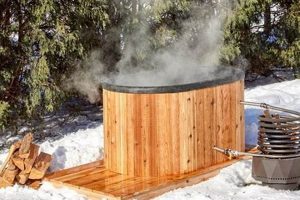
![[DIY Guide] Easy DIY Wood Window Shutters You Can Build! The DIY Hub: Creative Crafts, Repairs & Life Hacks [DIY Guide] Easy DIY Wood Window Shutters You Can Build! | The DIY Hub: Creative Crafts, Repairs & Life Hacks](https://craftingdiycenter.com/wp-content/uploads/2025/07/th-3579-300x200.jpg)
